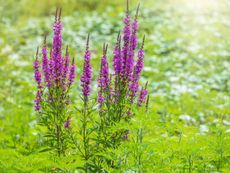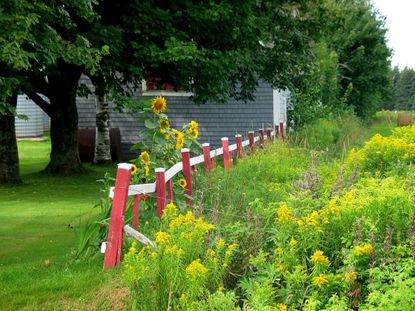Weeds
There are many types of garden weeds, making it difficult to know how to kill weeds, as not all methods work the same for all weed types. For this reason, we have attempted to make the task of weed control in lawns and gardens easier by providing tips on how to identify garden weeds. Once you know more about the common garden weeds found in the landscape, you’ll have a better idea on how to kill weeds that become bothersome. Whether it comes down to taking an organic approach or using a chemical method, our tips will alleviate future problems.
Weeds
-

Conventional Weed Killers
Conventional, or chemical, weed killers should be used sparingly; however, when done correctly, this method of control can save endless hours spent in the lawn or garden. Find out more in this article.
By Nikki Tilley
-

These Weeds That Spread By Seed Can Sprout After Years
Find out about weeds with long lasting seeds that can sprout and spread years later here.
By Laura Miller
-

Goatscaping: A Green Way To Get Rid Of Weeds
If you've ever wondered if, and how, you can hire goats for grazing weed control, click here for everything you need to know.
By Amy Grant
-

Grass Growing In Flower Bed: How To Kill Grass In Flower Beds
Grass can sometimes invade your flower beds, so try the strategies in this article for preventing and eliminating grassy weeds in your beds.
By Mary Ellen Ellis
-

Showy Rattlebox Control: Managing Showy Crotalaria In Landscapes
People make mistakes. Unfortunately, some of these mistakes can harm animals, plants, and our environment. One example is the introduction of non-native, invasive plants like the showy crotalaria. What is showy crotalaria? Click here for the answer.
By Darcy Larum
-

Broomsedge Plant: How To Get Rid Of Broomsedge
Broomsedge grass is a perennial, native weed reseeding from the heads of the broomsedge plant. The best way to get rid of broomsedge in the lawn is to stop it before it can spread. This article will help.
By Becca Badgett
-

Crabgrass Varieties: Information On Types Of Crabgrass Weeds
There are many different types of crabgrass. How many types of crabgrass are there? There are nearly 35 different species, depending upon whom you ask. Learn more about the most common forms of crabgrass in this article.
By Bonnie L. Grant
-

Purple Loosestrife Info - Tips For Purple Loosestrife Control
The purple loosestrife plant is an extremely invasive perennial. It has become a menace to the native plants where it chokes out the growth of all its competitors. This article has tips on how to control this weed.
By Jackie Rhoades
-

Managing Henbanes – Black Henbane Weed Info And Growing Conditions
What is henbane? Henbane was introduced to North America from Europe. It has escaped cultivation since that time and is now found across most of the United States. Click here to learn more about this plant and its control.
By Mary H. Dyer
-

Hairy Galinsoga Control: Tips For Controlling Shaggy Soldier Weeds
Shaggy soldier weed plants are serious weed pests in many areas. Also known as Galinsoga weeds, they can reduce yield by up to half in row crops. Use the facts from this article so you can safely and successfully combat this tenacious weed.
By Bonnie L. Grant
-

Hairy Bittercress Killer: Learn More About Control For Hairy Bittercress
Late winter and spring signal growth of all plants but especially weeds, like hairy bittercress weed. What is hairy bittercress? This article explains more as well as how to keep the weed under control.
By Bonnie L. Grant
-

Is Hairy Bittercress Edible – Learn How To Use Hairy Bittercress Weeds
What you may not realize as you’re hoeing or pulling weeds, is that although it may look like just another stubborn invader, hairy bittercress actually has a pungent, peppery flavor and many uses in the kitchen. The entire plant is edible. Click here to learn more.
By Mary H. Dyer
-

Greater Celandine Plant Info: Information About Celandine In Gardens
Greater celandine is an interesting, attractive flower known by several alternate names. Click on this article for greater celandine plant info, including concerns about greater celandine in gardens. Learn more here.
By Mary H. Dyer
-

Giant Hogweed Information – Tips For Controlling Giant Hogweed Plants
Giant hogweed is one scary plant. What is giant hogweed? It is a Class A noxious weed and is on several quarantine lists. Learn more about its control and where it grows in this article. Click here for additional information.
By Bonnie L. Grant
-

How To Use Garlic Mustard Plants – Garlic Mustard Recipes And Harvest Tips
Curious about garlic mustard edibility? Garlic mustard may have tasty potential, but it is a noxious weed. It is a biennial plant that can be used in cooking but whose presence is potentially damaging to native flora. Learn more about using garlic mustard plants in this article.
By Bonnie L. Grant
-

Nettleleaf Goosefoot Weed Control: How To Get Rid Of Nettleleaf Goosefoot
Goosefoot is an annual weed closely related to chard and spinach. It invades lawns and gardens throughout the U.S., and if left to its own devices, it can take over. Learn about nettleleaf goosefoot identification and control in this article.
By Jackie Carroll
-

How To Kill Grass Naturally – Kill Unwanted Grass In Your Yard
There are natural ways to kill unwanted grass without introducing chemicals into the home landscape. So if you have a patchy lawn, grass weeds or an area of sod you want removed for a garden bed, click this article for tips on how to get rid of grass naturally.
By Bonnie L. Grant

